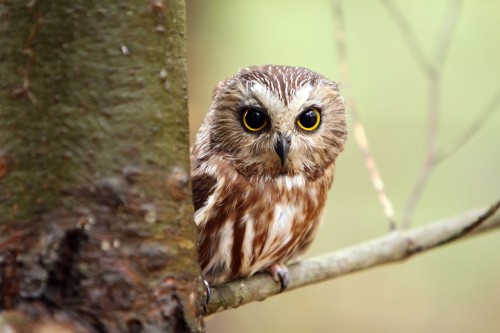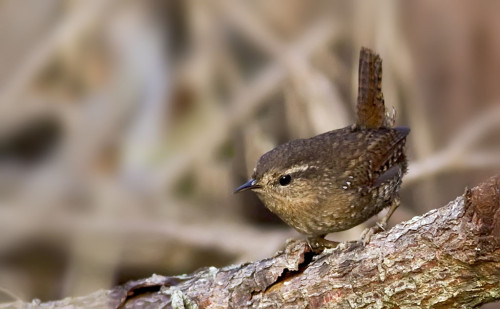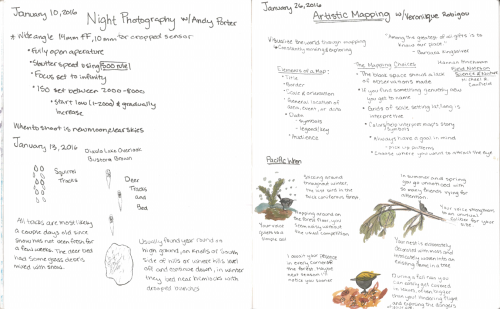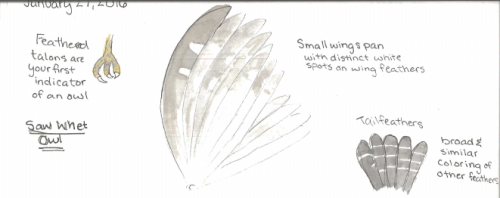Natural Notes on the Pacific Wren and Saw Whet Owl

By Hannah Newell, a M.Ed. Graduate student of the Institute’s 15th Cohort
Pacific Wren
This avian is a year round resident in our coniferous forests but to me has gone unnoticed until fall when all the other commanding voices of spring and summer have slowly disappeared. The first one I noticed was on a typical rainy fall day with leaf litter covering any empty space on the forest floor. This unfortunate wren had gotten stuck under a leaf just as big as it’s tiny body and was trying desperately to fly away from my forthcoming presence. After a few flitters and hops around, it was able to free itself from the leaf and left me laughing to myself in a quiet forest.

Pacific Wren. Photo courtesy of seeingbirds.com
As we’ve come into the colder months of winter their call has morphed into a short and quiet chirp that they use as they hop around the forest floor looking for food. More often than not, I hear their hopping before I see their bodies emerge from the leafy debris under my feet. To my amazement they seem at home in the cold, snowy forest. One has to wonder how their tiny bodies cope with the extreme cold.

Hannah’s notes on the Pacific Wren (bottom right) in her journal.
I’ve heard that in summer and spring they make intricately woven nests of moss that are attached to root balls or thickly branched trees. Their call becomes strengthened and elongated to rival those of the big shots (pileated woodpecker, american robin). I’m looking forward to my continued observation of this small yet powerful bird.
Saw Whet Owl
Shortly after our cohort returned to campus after our winter break, I found a pile of feathers on the Peninsula Trail (a circular 0.2mi trail that cuts up right next to the bank of Diablo lake). They were a light greyish brown with white spots and looked like fuzzy belly feathers. Piled in a small circle, I examined the feathers closer and as my eyes wandered across the ground I found it’s small, mangled body. Head gone, belly gone, all that was left was two wings, two strong feathered talons and a detached spine.
With these clues, I took photos and went to the library to do some research. Finding a feather is a very hard way to identify birds if you’re a novice, but with clues like those feathered talons and the size of its wingspan makes it easier to determine that it is a small owl. In this area, the typical small owls that are present in the winter is either a Saw Whet or a Northern Pygmy owl. Now the feathers come into play because the Northern Pygmy has a lot more white on it’s belly and has an overall more brown appearance.

Hannah’s notes on the Saw Whet Owl in her journal.
Naturalizing and tracking are together a dance between playing the roles of Sherlock Holmes and Jeff Corwin. It is a constant mixture of knowledge of the animal and the attempt to step into the shoes of that animal to see where it went and what it was up to.
My bet is that while the Environmental Learning Center was quiet and desolate during our winter break, a bobcat had taken to roaming the grounds and possibly held up in the abandoned boat house right near the water’s edge (I also found possible tracks). While on one of it’s regular rounds of the ground, it spotted a Saw Whet owl sitting in a tree. Slowly it climbed up the the tree and adeptly pounced on it’s prey, bringing it down to the ground to devour it’s feast.
Whether or not my prediction is correct, finding the clues and creating a story is the best part of my work study position in field sciences.
We also had an experience with this small species during our summer natural history retreat. As Joe Loviska, also part of the 15th cohort, recounts (you can also hear him recount in his own voice with the full audio):
Joe’s Saw Whet Story (Audio File)
So it was the final day of our 10 day backpacking trip over the summer and we ended up at Johannesburg campground that’s right below Cascades Pass. It’s this weird campground where you have to kindof hike this side trail through this really steep old growth. It’s not really cleared at all and it’s on a very steep hillside so you have these really awkward tent paths that are barely even there and perched on a side of a hill.
So we were hanging out there napping and kindof grumpy after dinner ’cause it was an awkward spot to sit. The light was failing and all of a sudden there was this flitting around above our heads. I looked up and I thought “Oh there’s a bat hunting right here.” And so we watched it for a minute as it was flitting around. This was in pretty tall, old growth forest. Then it perched. It was flying really quickly and darting then suddenly it perched on a branch. I realized right away “That’s not a bat. That’s an owl!” It had the perfect ovular shape to it.
We watched it with new eyes and it was just the most incredible thing to see this tiny little owl. It would just dive off the branch and fly in a few quick circles and then come back and perch on the same branch. It was perfectly silent, just like a bat. It was incredbile to see. So for awhile we watched it as the light failed. I thought “That’s a Saw Whet Owl. I’ve never seen one before.” But then I was confused or I was doubtful becasue I thought “Oh maybe it’s a Pygmy Owl instead.”
I then went and looked it up and I saw that Pygmy Owl’s have a longer tail and I believe they make a little bit of noise in flight. Whereas Saw Whets have a short tail and are perfectly silent and that’s what this bird was.
It was a really magical experience at Johannesburg campground.
Cover photo courtesy of pugetsoundbirds.org

